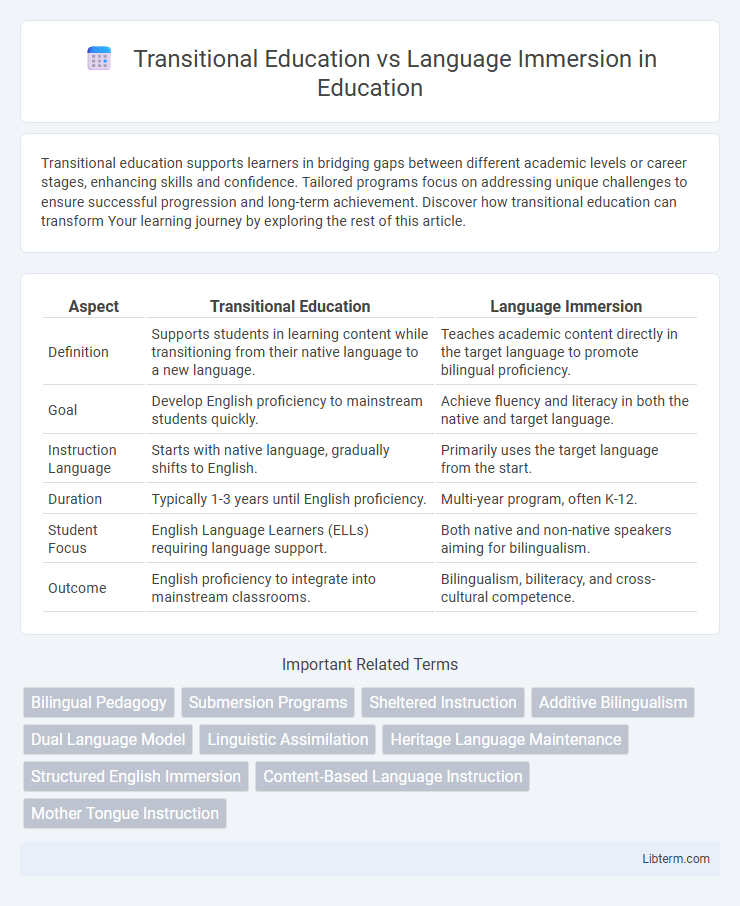Transitional education supports learners in bridging gaps between different academic levels or career stages, enhancing skills and confidence. Tailored programs focus on addressing unique challenges to ensure successful progression and long-term achievement. Discover how transitional education can transform Your learning journey by exploring the rest of this article.
Table of Comparison
| Aspect | Transitional Education | Language Immersion |
|---|---|---|
| Definition | Supports students in learning content while transitioning from their native language to a new language. | Teaches academic content directly in the target language to promote bilingual proficiency. |
| Goal | Develop English proficiency to mainstream students quickly. | Achieve fluency and literacy in both the native and target language. |
| Instruction Language | Starts with native language, gradually shifts to English. | Primarily uses the target language from the start. |
| Duration | Typically 1-3 years until English proficiency. | Multi-year program, often K-12. |
| Student Focus | English Language Learners (ELLs) requiring language support. | Both native and non-native speakers aiming for bilingualism. |
| Outcome | English proficiency to integrate into mainstream classrooms. | Bilingualism, biliteracy, and cross-cultural competence. |
Understanding Transitional Education
Transitional education supports English language learners by providing instruction in their native language alongside English to build foundational academic skills while gradually increasing English proficiency. This approach helps students maintain content knowledge during language acquisition, preventing gaps in learning and easing their transition into mainstream classrooms. Understanding transitional education highlights its role in balancing language development with academic achievement for bilingual learners.
Exploring Language Immersion Programs
Language immersion programs immerse students directly in the target language environment, accelerating fluency through constant exposure and practical use. These programs emphasize bilingual proficiency and cultural understanding by integrating academic subjects with language learning, often resulting in higher cognitive flexibility and improved communication skills. Unlike transitional education, which prioritizes gradual language acquisition alongside native language support, immersion fosters rapid adaptation and deep linguistic competence.
Key Differences Between Transitional Education and Language Immersion
Transitional education primarily aims to support non-native speakers in acquiring academic content while gradually introducing English, emphasizing bilingual instruction and scaffolding to build language proficiency. Language immersion, by contrast, involves teaching students predominantly or entirely in the target language to promote fluency and cultural competence through immersive experiences. Key differences include the goal of transitional education to bridge to mainstream education using both languages, whereas language immersion seeks immediate immersion in the target language for rapid linguistic and cognitive development.
Cognitive Benefits of Each Approach
Transitional education promotes cognitive development by reinforcing first-language skills while gradually introducing a second language, supporting metalinguistic awareness and better problem-solving abilities. Language immersion enhances executive functions such as cognitive flexibility and working memory through constant exposure to a second language in various contexts, accelerating bilingual fluency. Both approaches stimulate neuroplasticity but differ in the degree and speed of cognitive benefits related to bilingual language acquisition.
Academic Outcomes: Comparative Analysis
Transitional education programs emphasize gradual language acquisition alongside content instruction, often resulting in moderate academic performance gains among English Language Learners (ELLs). Language immersion approaches provide intensive exposure to both the target language and academic content, leading to higher proficiency levels and improved standardized test scores in core subjects. Comparative studies indicate that immersion students typically outperform transitional education peers in long-term academic outcomes, particularly in vocabulary development, reading comprehension, and mathematics achievement.
Cultural Integration and Student Identity
Transitional education programs support cultural integration by gradually introducing students to the dominant language and cultural norms while maintaining their native language, fostering a balanced bilingual identity. Language immersion immerses students fully in a new language environment, accelerating language acquisition and promoting deep cultural understanding, yet may challenge a student's connection to their original cultural identity. Effective educational strategies prioritize preserving students' native languages and cultural heritage alongside acquiring new linguistic skills to enhance both cultural integration and identity development.
Challenges and Limitations of Transitional Education
Transitional education often faces challenges such as limited exposure to the target language, which can hinder students' proficiency and confidence in real-world communication. This approach may also result in slower academic progress in the second language due to the reliance on the native language for instruction. Furthermore, transitional education can contribute to social segmentation and reduced cultural integration compared to immersive language programs.
Challenges and Limitations of Language Immersion
Language immersion programs face challenges such as limited accessibility due to high costs and lack of qualified bilingual teachers, which can hinder widespread implementation. Students may also experience initial confusion and slower academic progress in subjects taught in a second language, affecting overall learning outcomes. Furthermore, immersion programs sometimes struggle with balancing cultural preservation and curriculum standards, limiting their effectiveness in diverse educational settings.
Selecting the Right Approach for Diverse Learners
Selecting the right approach for diverse learners involves evaluating students' language proficiency, cultural background, and learning goals to determine whether Transitional Education or Language Immersion better supports their development. Transitional Education facilitates gradual integration by using the native language alongside English, promoting comprehension and confidence in academic subjects. Language Immersion, characterized by intensive exposure to the second language, accelerates fluency and cultural adaptability but requires greater initial language support to prevent learner frustration.
Future Trends in Bilingual Education
Future trends in bilingual education emphasize integrating transitional education methods with language immersion programs to enhance cognitive development and academic achievement among diverse learners. Emerging research highlights technology-driven personalized instruction and culturally responsive curricula as pivotal in supporting language acquisition and fluency in both native and second languages. Educators increasingly adopt hybrid models combining scaffolded language support with immersive experiences to prepare students for global communication and multicultural environments.
Transitional Education Infographic

 libterm.com
libterm.com